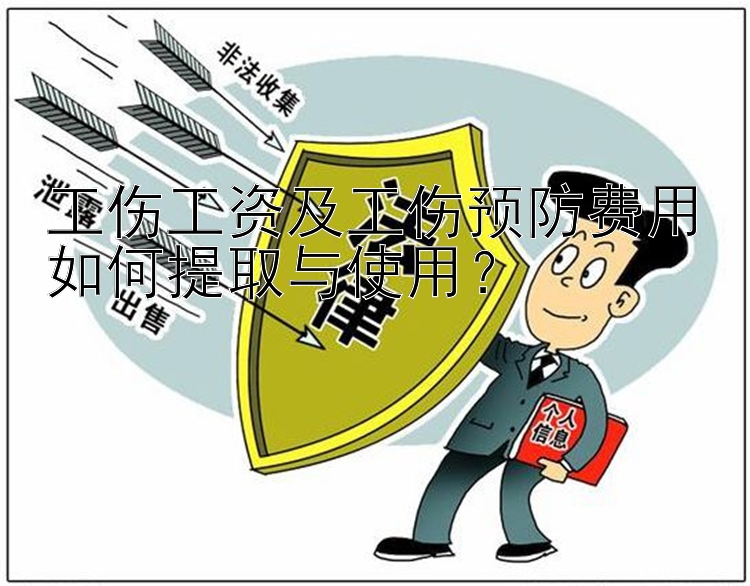工伤工资及工伤预防费用如何提取与使用?
工伤是指因工作原因导致的意外伤害或职业病。在现代社会中,为了保护劳动者的权益和保障其身体健康,各国都制定了相应的工伤保险制度。在中国,《中华人民共和国社会保险法》、《工伤保险条例》等法律法规对工伤的认定、工伤待遇以及工伤预防和康复等方面进行了详细规定。本文将围绕“工伤工资及工伤预防费用如何提取与使用”这一主题进行探讨。
一、工伤工资的提取与使用
根据《工伤保险条例》第三十三条的规定,职工因工受伤或者患职业病的,在停工留薪期内,原工资福利待遇不变,由所在单位按月支付。停工留薪期一般不超过12个月,伤情严重或者情况特殊,经设区的市级劳动能力鉴定委员会确认,可以适当延长,但延长不得超过12个月。工伤职工评定伤残等级后,停发原待遇,按照本章的有关规定享受伤残待遇。工伤职工在停工留薪期满之后仍需治疗的,继续享受工伤医疗待遇。
工伤工资的提取通常是通过企业每月从经营成本中划拨一定比例的资金,或者通过缴纳工伤保险费的方式进行的。而工伤工资的使用则是用于支付职工在停工留薪期间的原工资福利待遇。如果职工不幸去世,则该笔资金可用于抚恤其亲属。
二、工伤预防费用的提取与使用
为了减少工伤事故的发生率,各用人单位应当采取积极的措施来进行工伤预防。根据《工伤保险条例》第十四条的规定,工伤保险基金应当预留一定的费用,用于下列项目的支出:(一)工伤预防的宣传、培训;(二)工伤认定、劳动能力鉴定的调查核实;(三)工伤职工的辅助器具配置;(四)法律、法规规定的其他项目。
工伤预防费用的提取主要来源于工伤保险费的征收。依据《工伤保险条例》第八条规定,工伤保险费根据以支定收、收支平衡的原则确定。因此,工伤保险费的收取会考虑到工伤预防所需的开支。
工伤预防费用的使用主要包括以下几个方面:
-
宣传和教育活动:通过举办讲座、发放宣传资料等方式向广大职工普及安全知识和技能,提高他们的自我防护意识。
-
培训和演练:组织各类安全培训课程,包括急救技能、消防演习、紧急逃生技巧等,确保员工在面对突发状况时能做出正确的反应。
-
设施改善:对生产环境和工作条件进行检查,发现问题及时整改,如更换老旧设备、安装安全装置等,从而降低事故发生风险。
-
评估和咨询服务:聘请专业机构对企业的安全生产情况进行评估,并提供咨询建议,帮助企业制定更加完善的安全生产管理制度。
-
新技术研发:支持科研机构和企业在工伤预防领域的新技术开发,推动先进技术和设备的应用,进一步提高工作效率和安全水平。
-
奖励机制:设立激励机制,鼓励员工积极参与工伤预防工作和提出改进意见,形成全员参与的良好氛围。
三、相关案例分析
案例1:某建筑公司一名工人因工地上的意外事故导致腿部骨折,被认定为工伤。公司在停工留薪期间内按时足额支付了该员工的工资,并在医院提供了必要的护理和治疗。随后,该员工经过康复训练后重返工作岗位,公司还为其调整了工作任务,以便更好地适应身体状况。
案例2:某化工企业定期开展工伤预防宣传活动,为员工提供安全培训和应急演练机会。在一次例行检查中发现部分生产线存在安全隐患,立即投入工伤预防经费对其进行改造升级,有效避免了可能的事故发生。同时,该公司还积极推行智能化管理,利用先进的技术手段提升生产效率和安全性能。
结论: 综上所述,工伤工资和工伤预防费用的提取与使用是工伤保险体系中的重要组成部分。合理有效地运用这些资金,不仅能保障工伤职工的基本生活需求,更能促进企业加强安全管理,减少事故发生,维护劳动者的合法权益和社会稳定发展。随着经济社会的不断进步和发展,有关连续
The topic of "How to extract and use work-related injury wages and work-related injury prevention expenses" is a critical aspect in ensuring the rights and welfare of workers, as well as promoting safe working environments within various industries. This article aims to provide an overview of relevant laws and regulations regarding these issues, along with examples for better understanding.
I. Extraction and Use of Work-Related Injury Wages
Work-related injury wages refer to the original salary and benefits that should be maintained during the medical leave period after a worker suffers from an occupational accident or illness due to their job duties. According to Article 33 of the Regulations on Work-Related Injuries, employees who are injured at work or suffer from an occupational disease will continue to receive their original wage and benefits during the stoppage of work period, which generally does not exceed 12 months. If the condition is severe or special circumstances exist, upon confirmation by the municipal labor capacity appraisal committee, the duration may be appropriately extended, but it cannot exceed another 12 months. After the employee has been assessed for disabilities, the original treatment stops, and they begin receiving disability benefits according to the provisions outlined in this chapter. Workers who still require treatment beyond the end of their stoppage of work period can continue to enjoy work-related injury healthcare services.
The extraction of work-related injury wages typically involves employers setting aside a portion of their operational costs each month, or by paying premiums for workplace insurance coverage. The usage of such funds is intended to cover the salaries and benefits of employees while they recuperate from their injuries or illnesses. Should a worker pass away, these funds would then be allocated towards providing financial support to their dependents.
II. Extraction and Use of Work-Related Injury Prevention Expenses
To reduce the occurrence of work-related injuries, employers must take proactive measures to prevent them. As stated in Article 14 of the Regulations on Work-Related Injuries, part of the premium collected for workplace insurance should be reserved for the following expenditures: (1) publicizing and training programs related to work safety; (2) investigations into cases involving claims for work-related injuries; (3) provision of assistive devices for disabled workers; and (4) any other projects stipulated by law or regulation.
These expenses are primarily derived from contributions made through workplace insurance premiums. Based on the principle of funding determined by expenditure levels and maintaining revenue balance, as specified in Article 8 of the Regulations on Work-Related Injuries, the collection of workplace insurance fees takes into account the need for spending on preventive measures.
Use of work-related injury prevention expenses often includes:
-
Public Awareness Campaigns - Organizing lectures, distributing materials, and engaging in other activities aimed at educating workers about safety knowledge and skills, thereby enhancing their self-protection awareness.
-
Training Programs and Exercises - Conducting various safety training courses, including first aid skills, fire drills, emergency evacuation techniques, etc., to ensure that employees know how to respond correctly in unexpected situations.
-
Facility Improvement - Inspecting production environments and working conditions regularly, identifying potential hazards promptly, making necessary renovations (such as replacing outdated equipment or installing protective devices) to lower the risk of accidents occurring.
-
Evaluation Services and Consultations - Engaging professional institutions to evaluate the company's production safety situation and offer advice, helping enterprises formulate more comprehensive occupational health and safety management systems.
-
Research and Development of New Technologies - Supporting research institutes and businesses in developing new technologies for preventing work-related injuries, driving advanced technology and equipment applications that further improve efficiency and safety standards.
-
Reward Mechanisms - Establishing incentive mechanisms to encourage employees to participate actively in work-related injury prevention efforts and submit improvement suggestions, fostering a corporate culture where everyone contributes to safer operations.
III. Case Studies
Case Study 1: A construction company paid full compensation to one of its workers who suffered a broken leg in a site incident leading to a work-related injury determination. During the recovery process, the firm ensured timely payment of wages and provided nursing care and treatments in the hospital. Once the employee completed rehabilitation training and returned to work, the company adjusted his tasks to accommodate his physical capabilities better.
Case Study 2: A chemical enterprise regularly conducts campaigns to promote work-related injury prevention among staff members, offering safety training sessions and conducting simulation exercises. Through routine inspections, the company identified safety concerns in some production lines and invested in upgrading facilities using reserve funds designated for work-related injury prevention purposes. Simultaneously, the company also promoted intelligent management by leveraging cutting-edge technological means to enhance both productivity and security levels.
Conclusion: In conclusion, extracting and utilizing work-related injury wages and prevention expenses play crucial roles in safeguarding the interests and welfare of employees while encouraging organizations to strengthen their safety protocols and minimize the likelihood of incidents. With continuous economic and social development, legislation concerning these matters will undoubtedly evolve, reflecting changing needs and advancements in protecting those engaged in gainful employment across all sectors of society.
-

工伤工资及工伤预防费用如何提取与使用?
2024-12-160 人看过工伤是指因工作原因导致的意外伤害或职业病。在现代社会中,为了保护劳动者的权益和保障其身体健康,各国都制定了相应的工伤保险制度。在中国,《中华人民共和国社会保险法》、《工伤保险条...